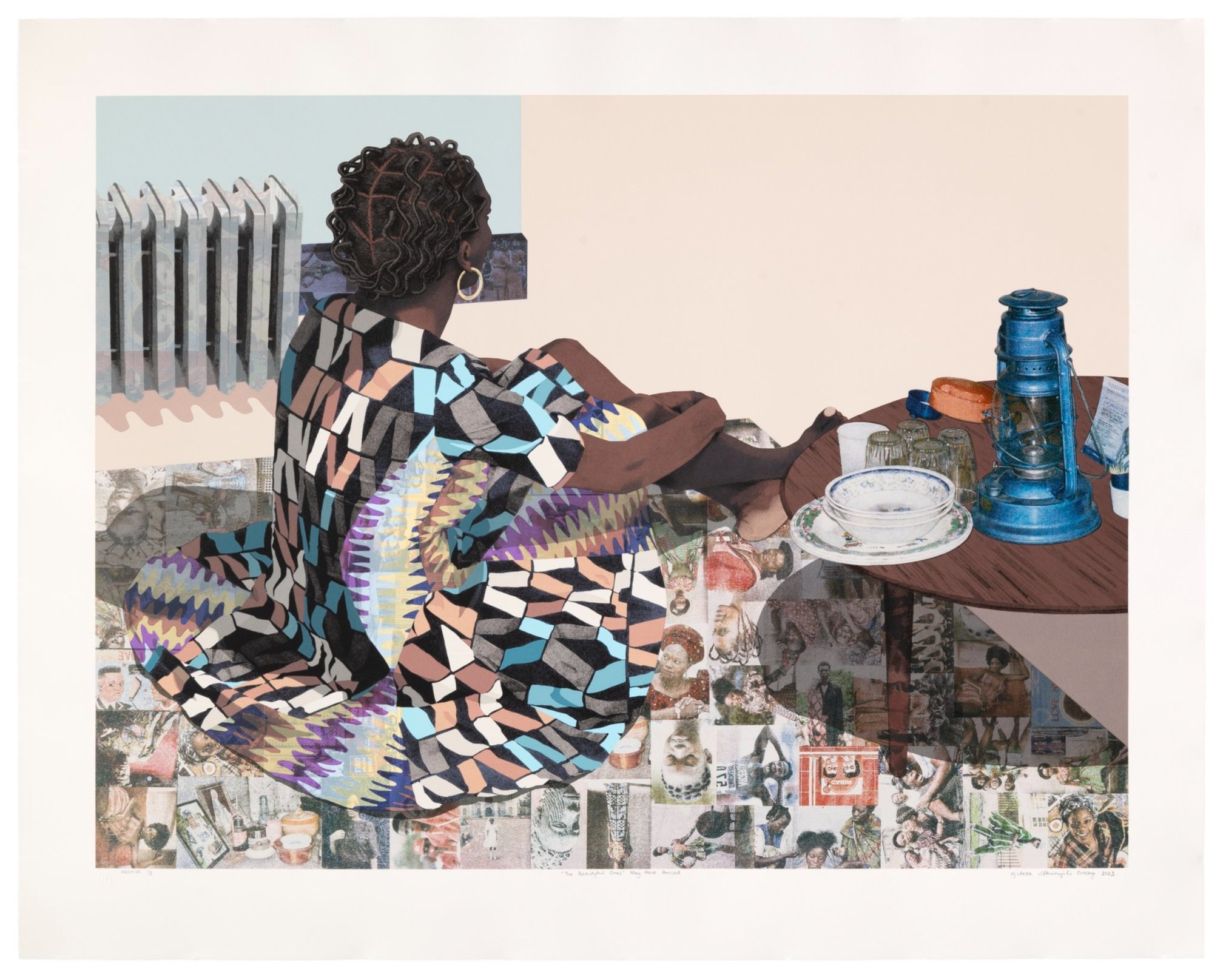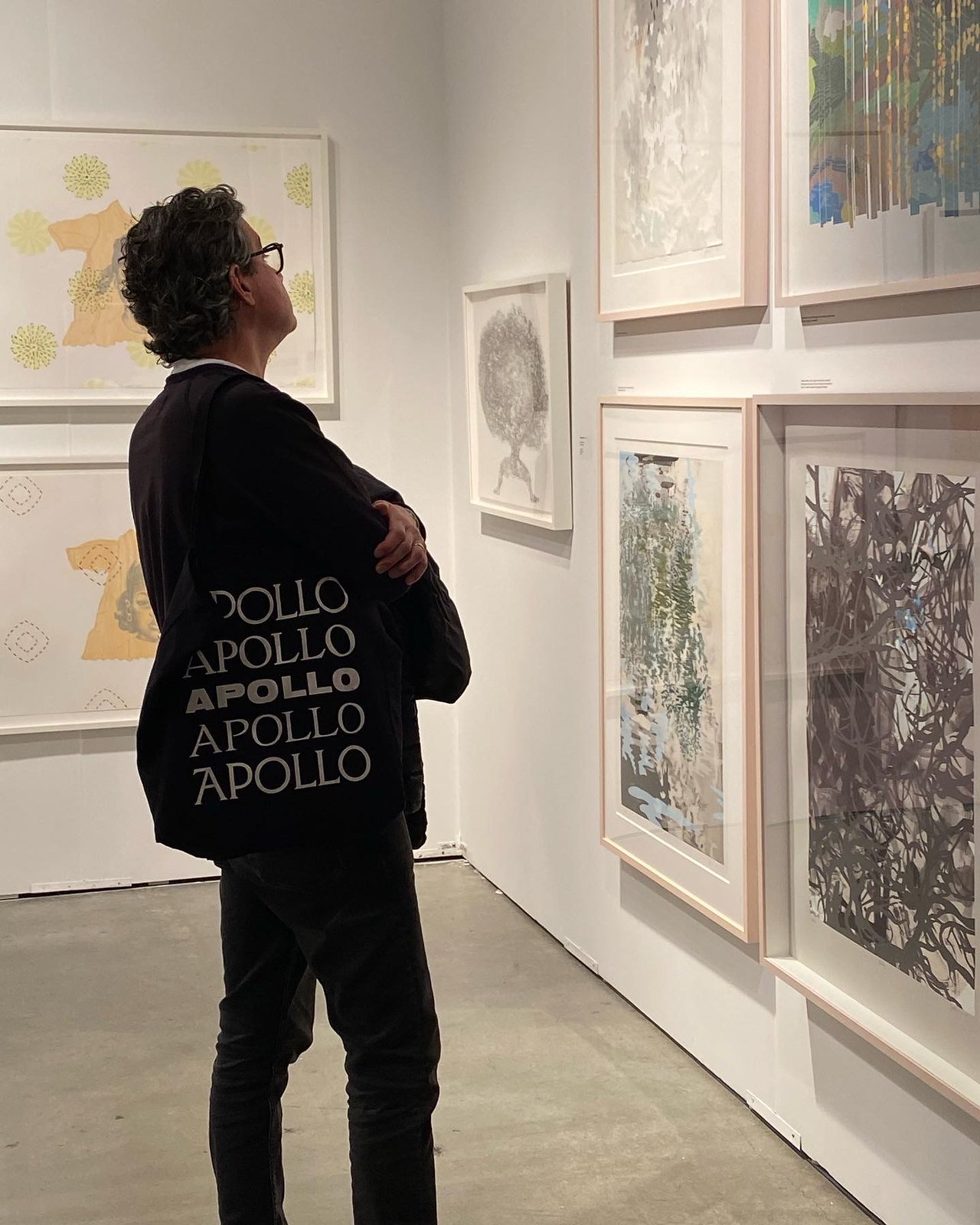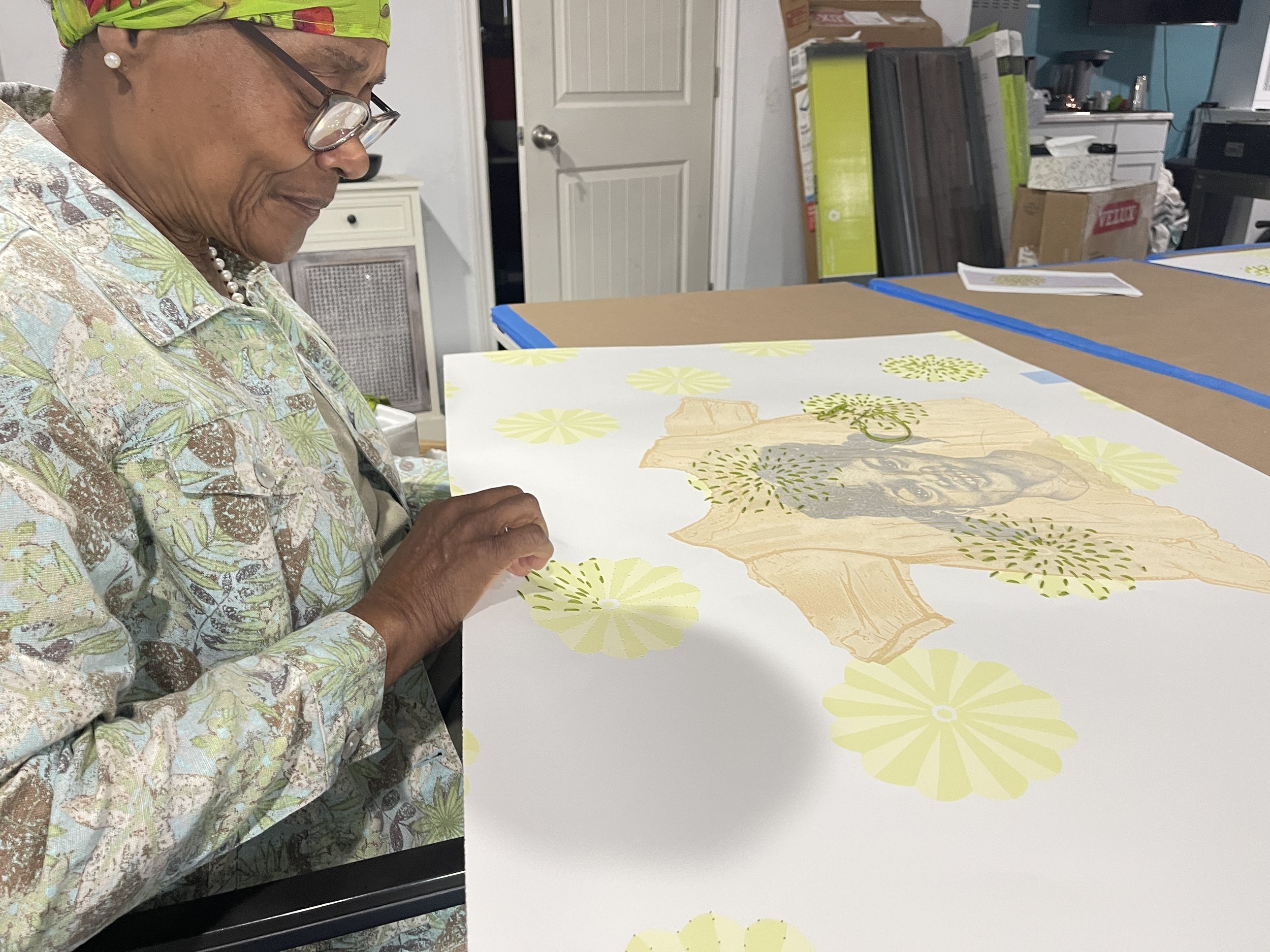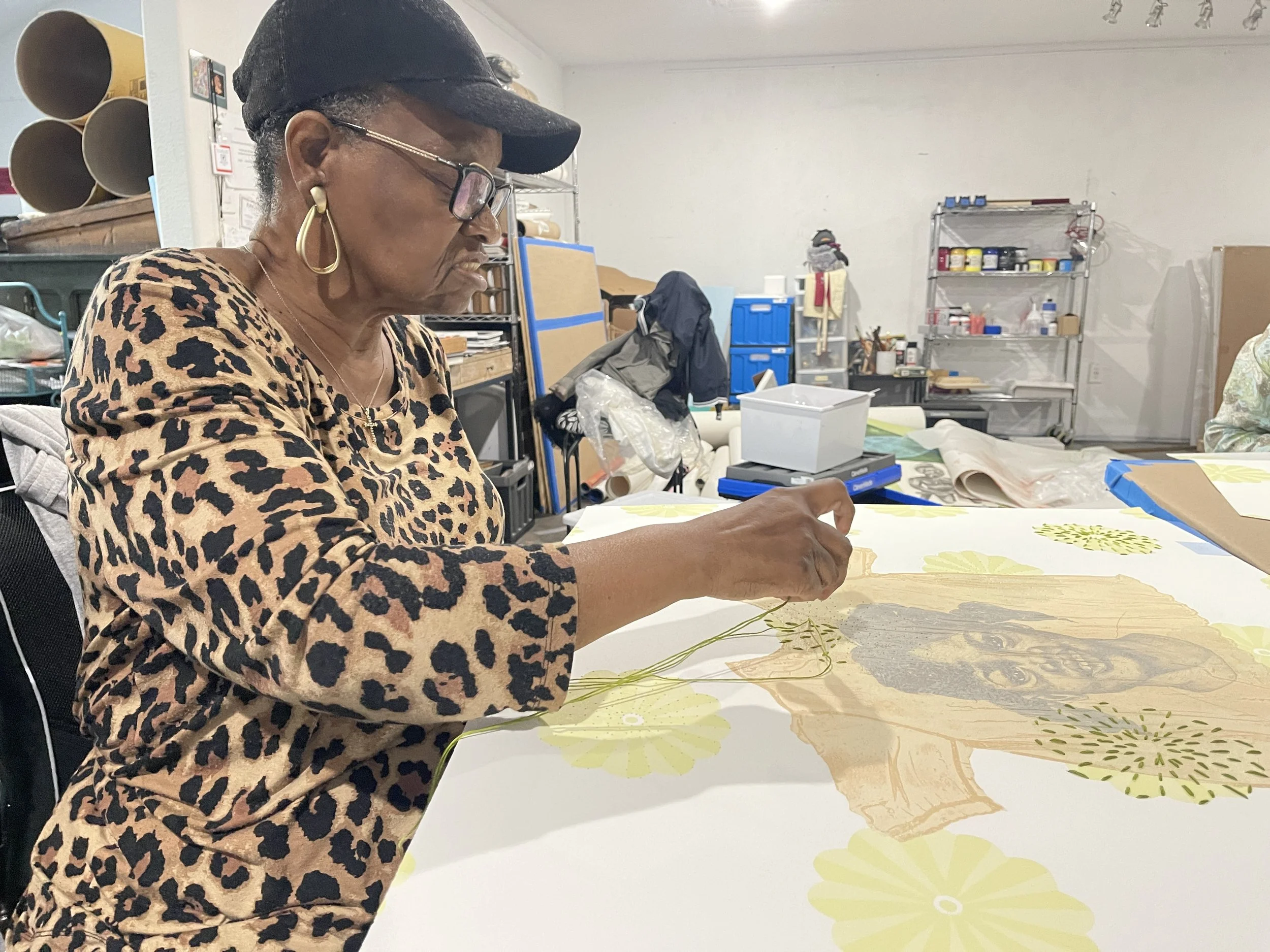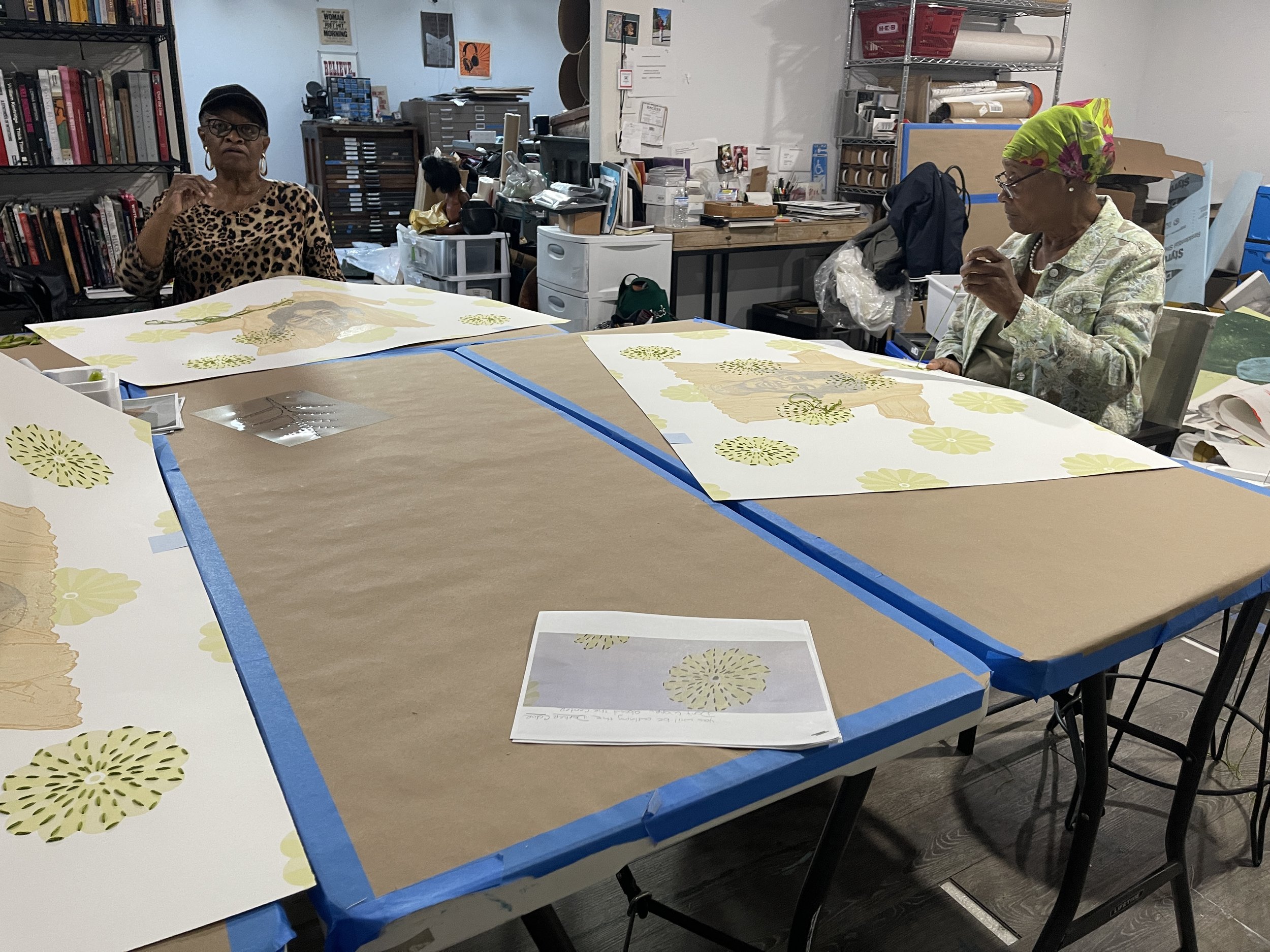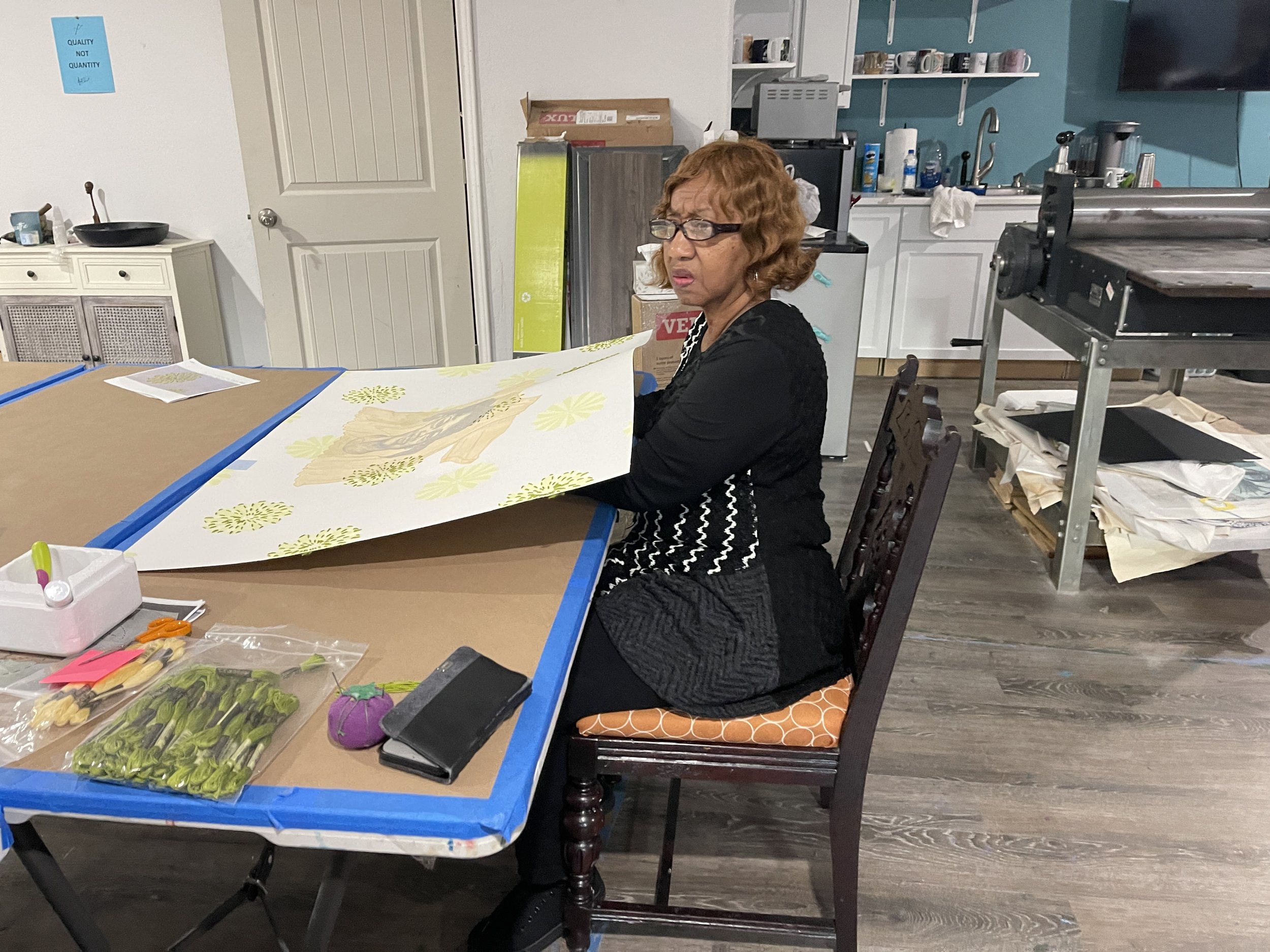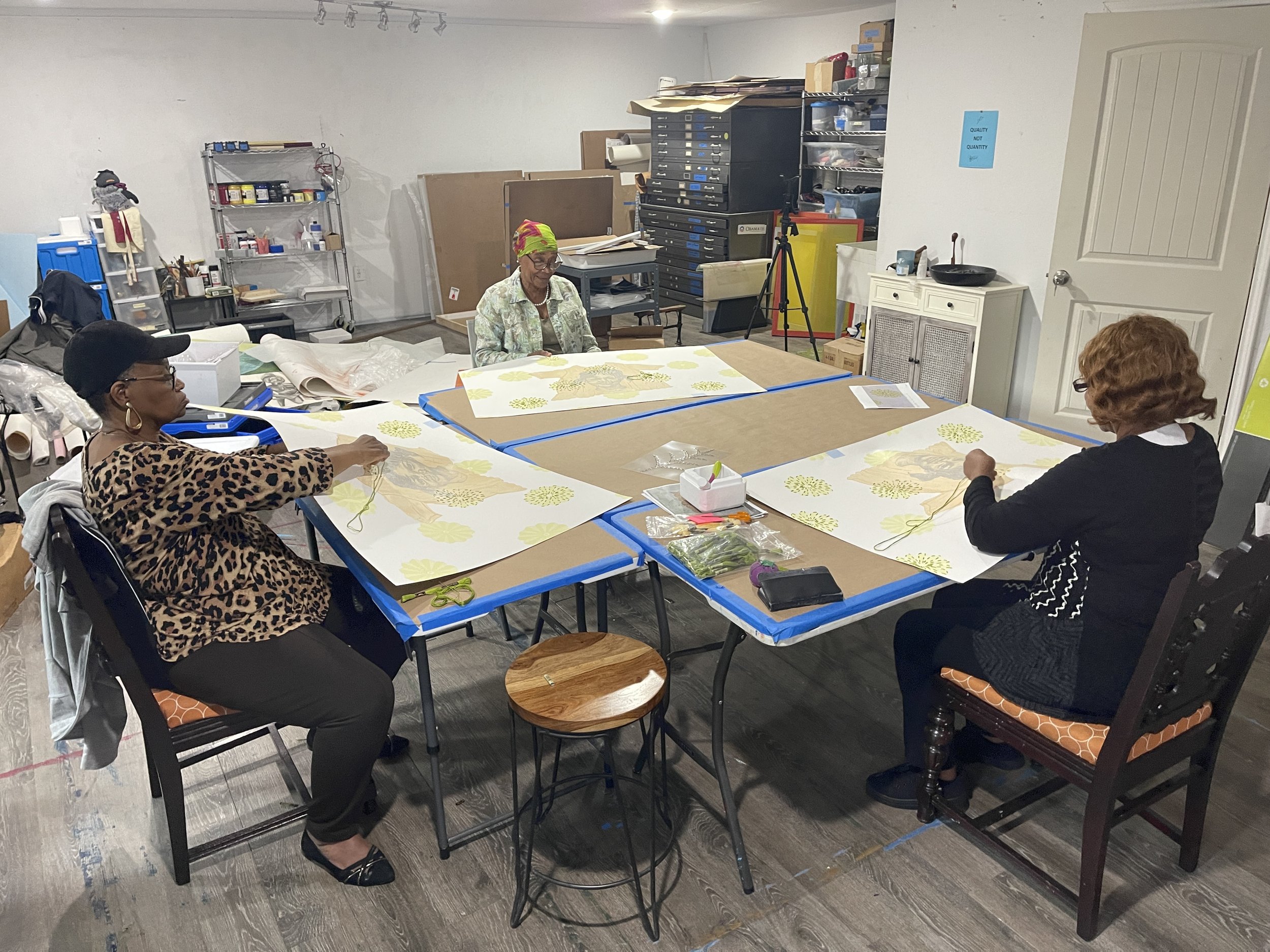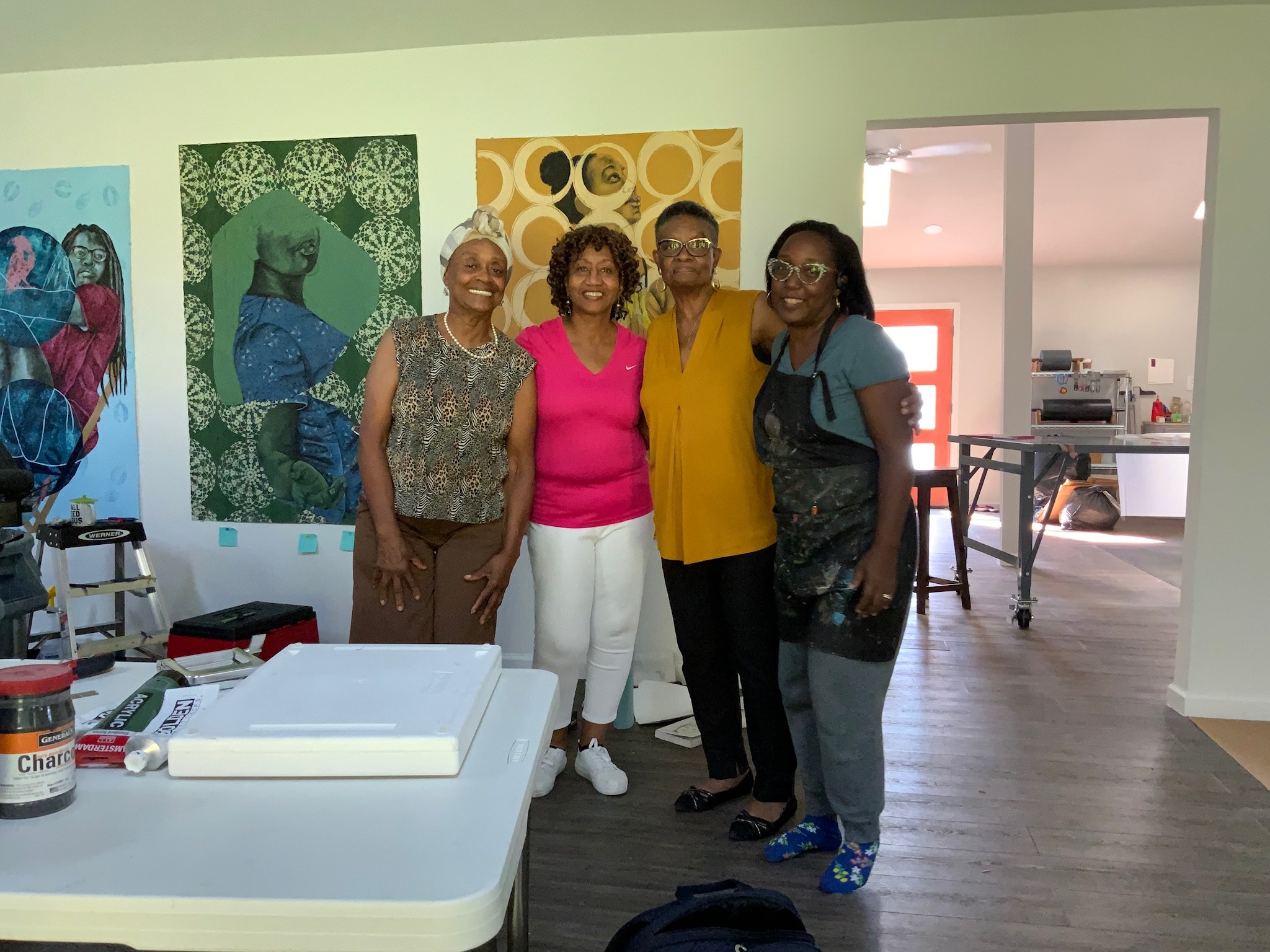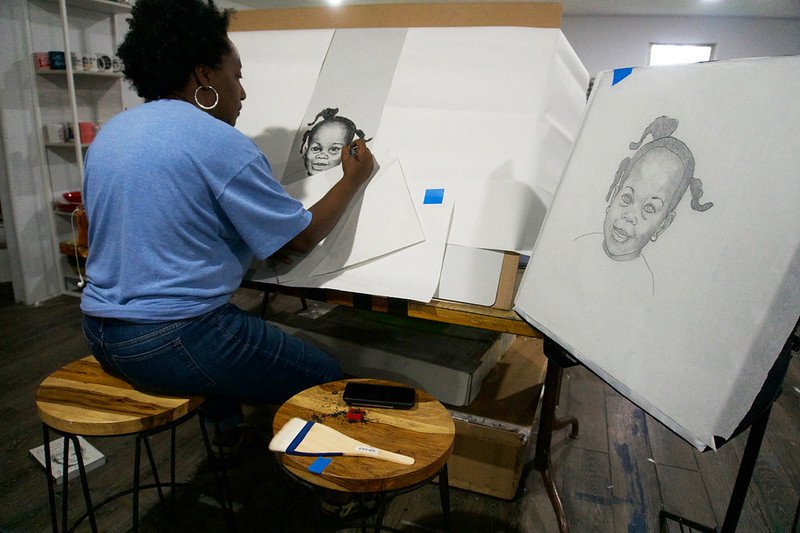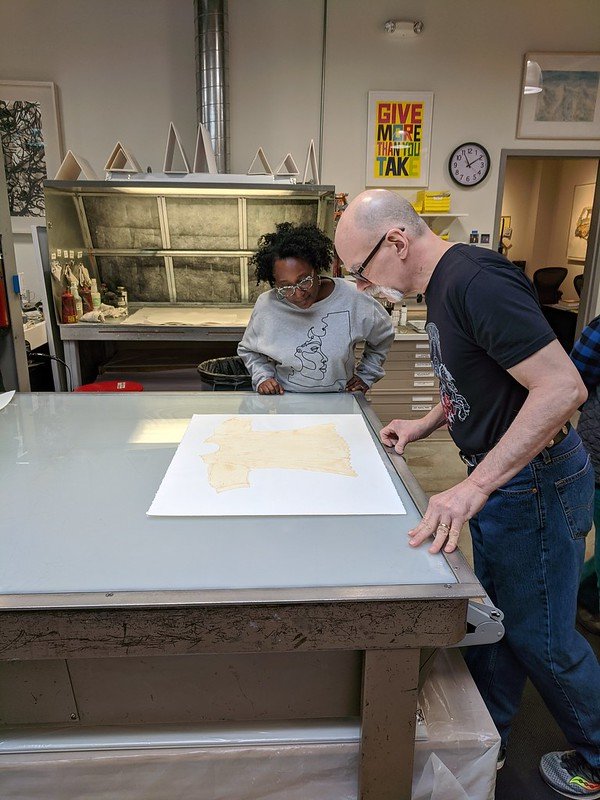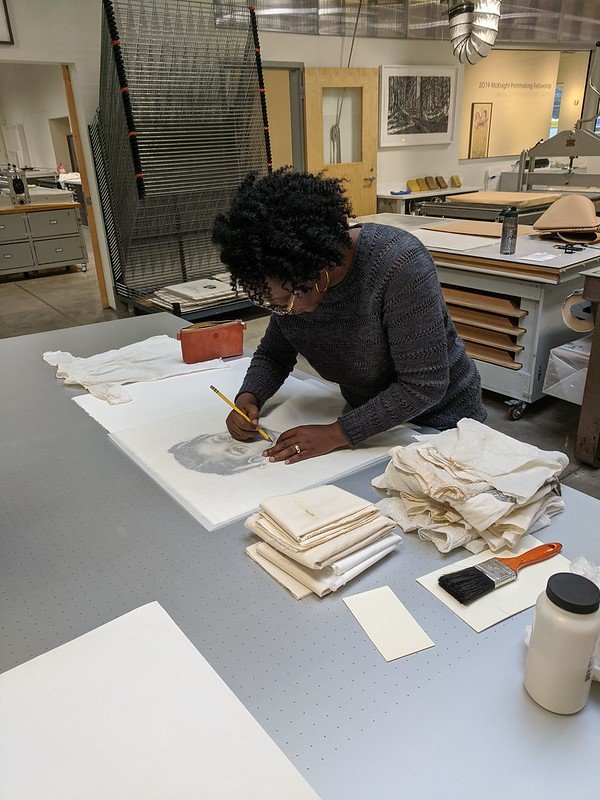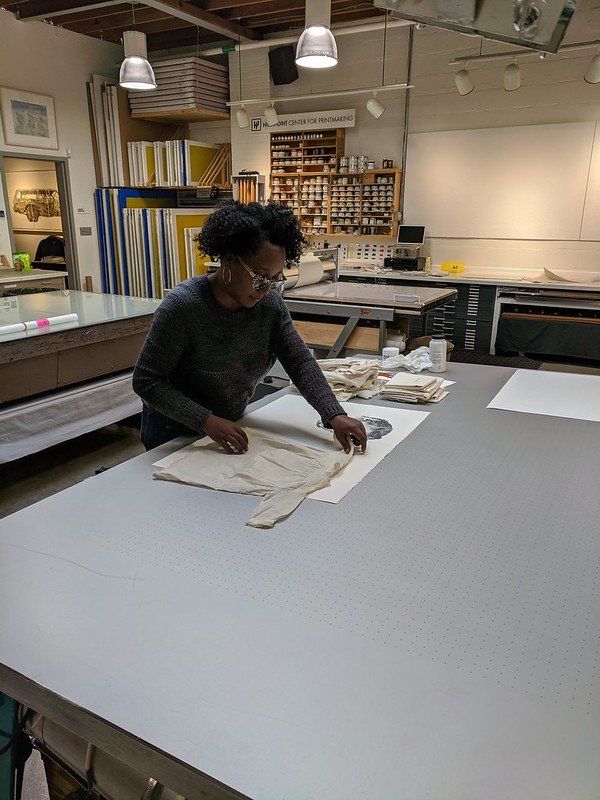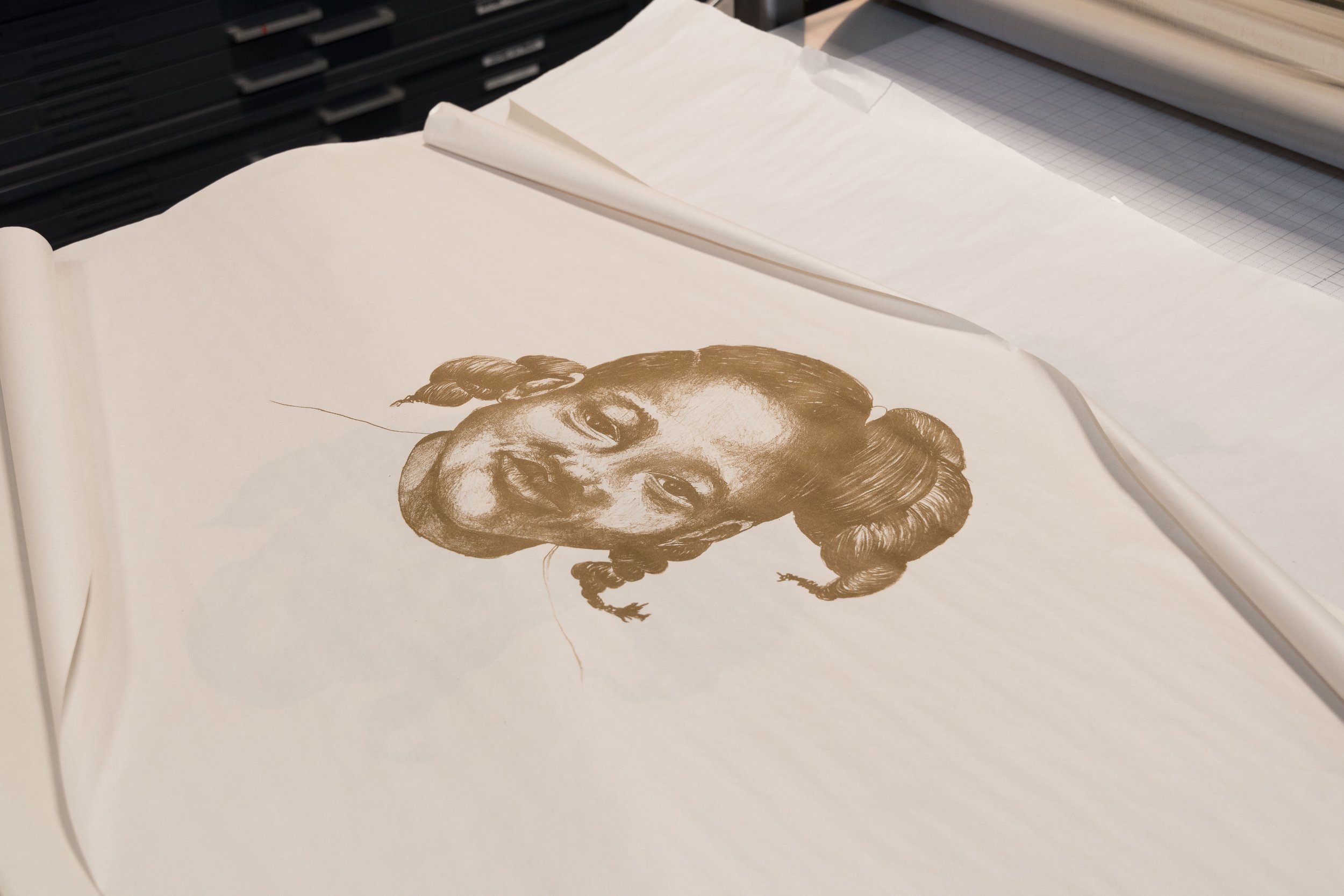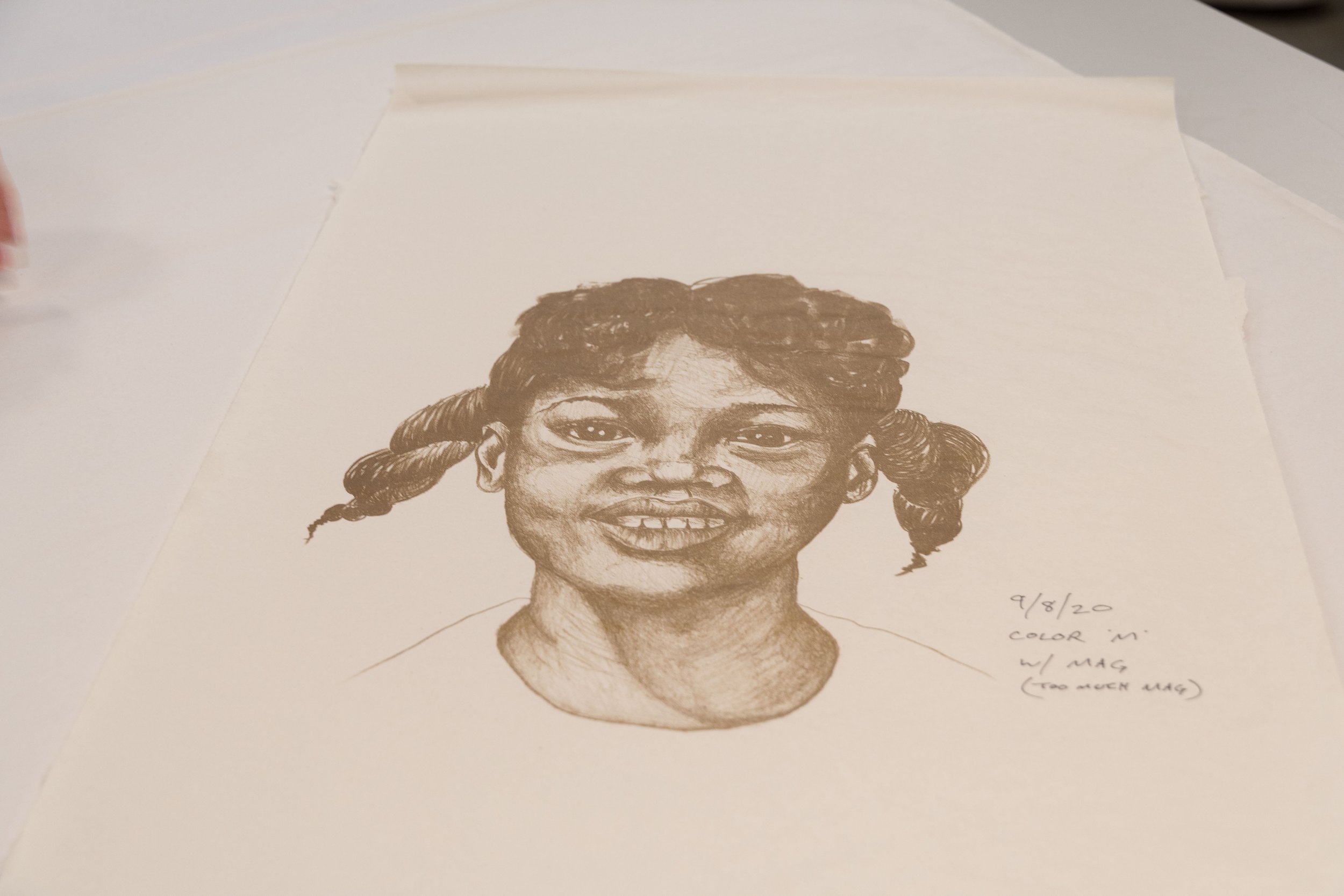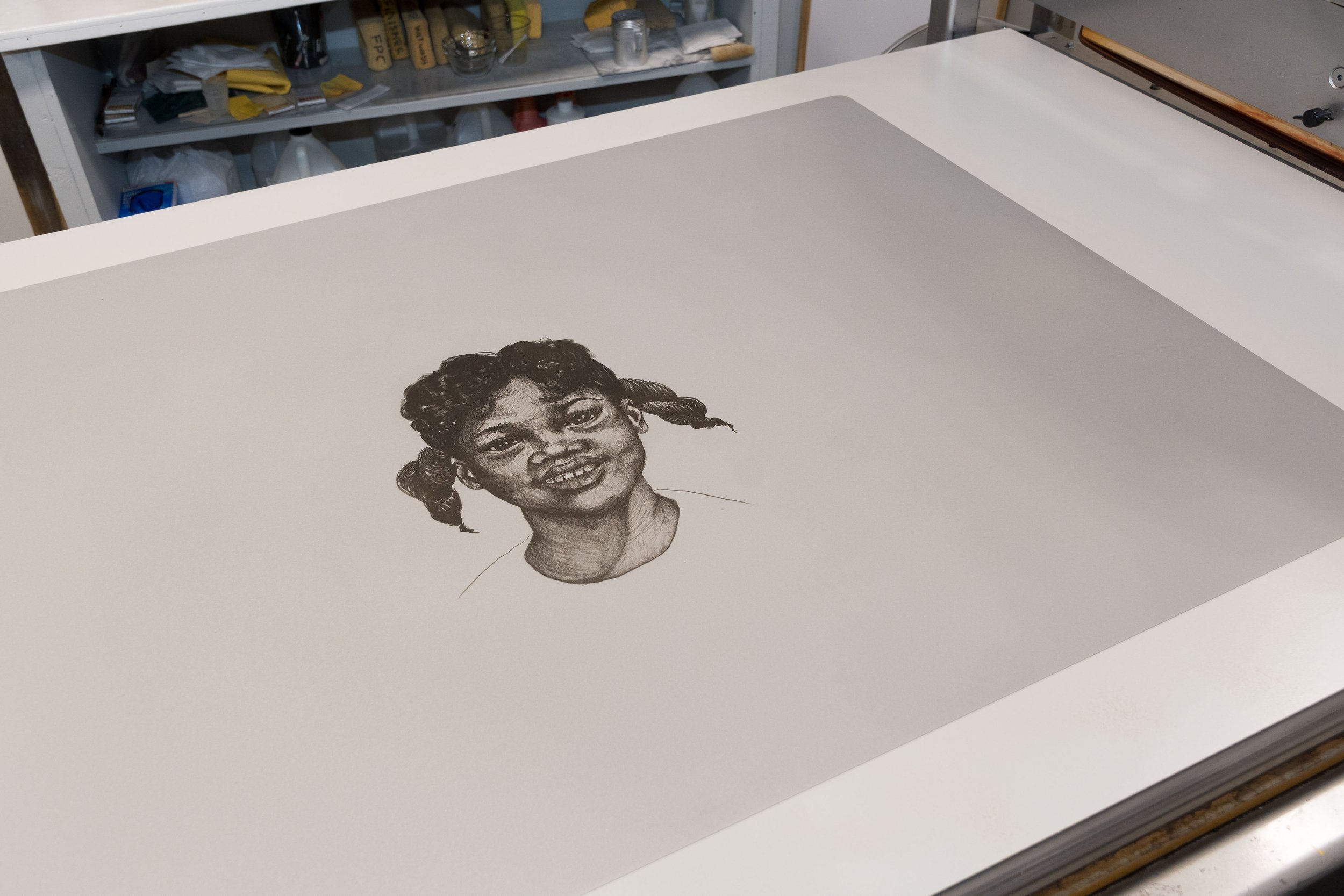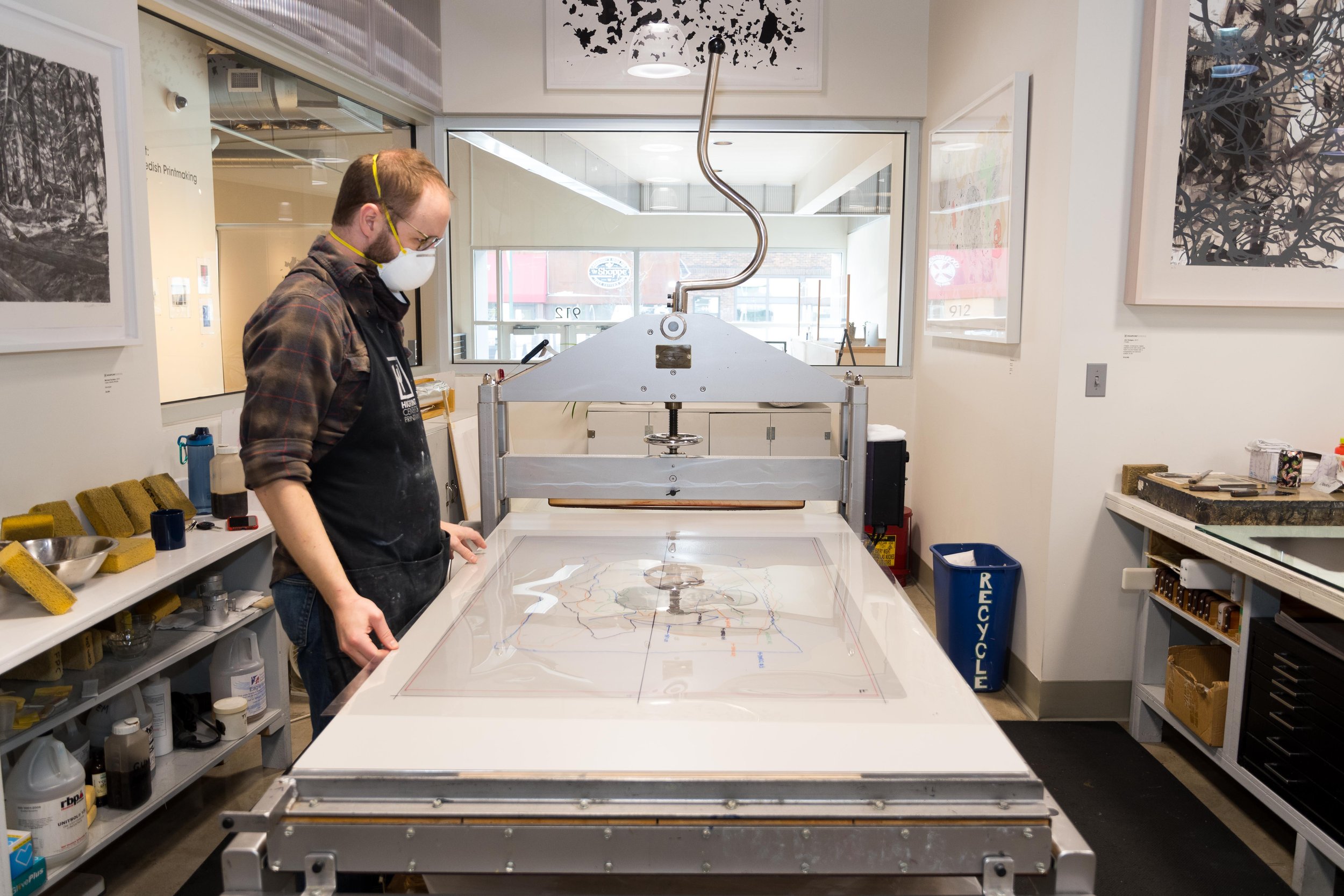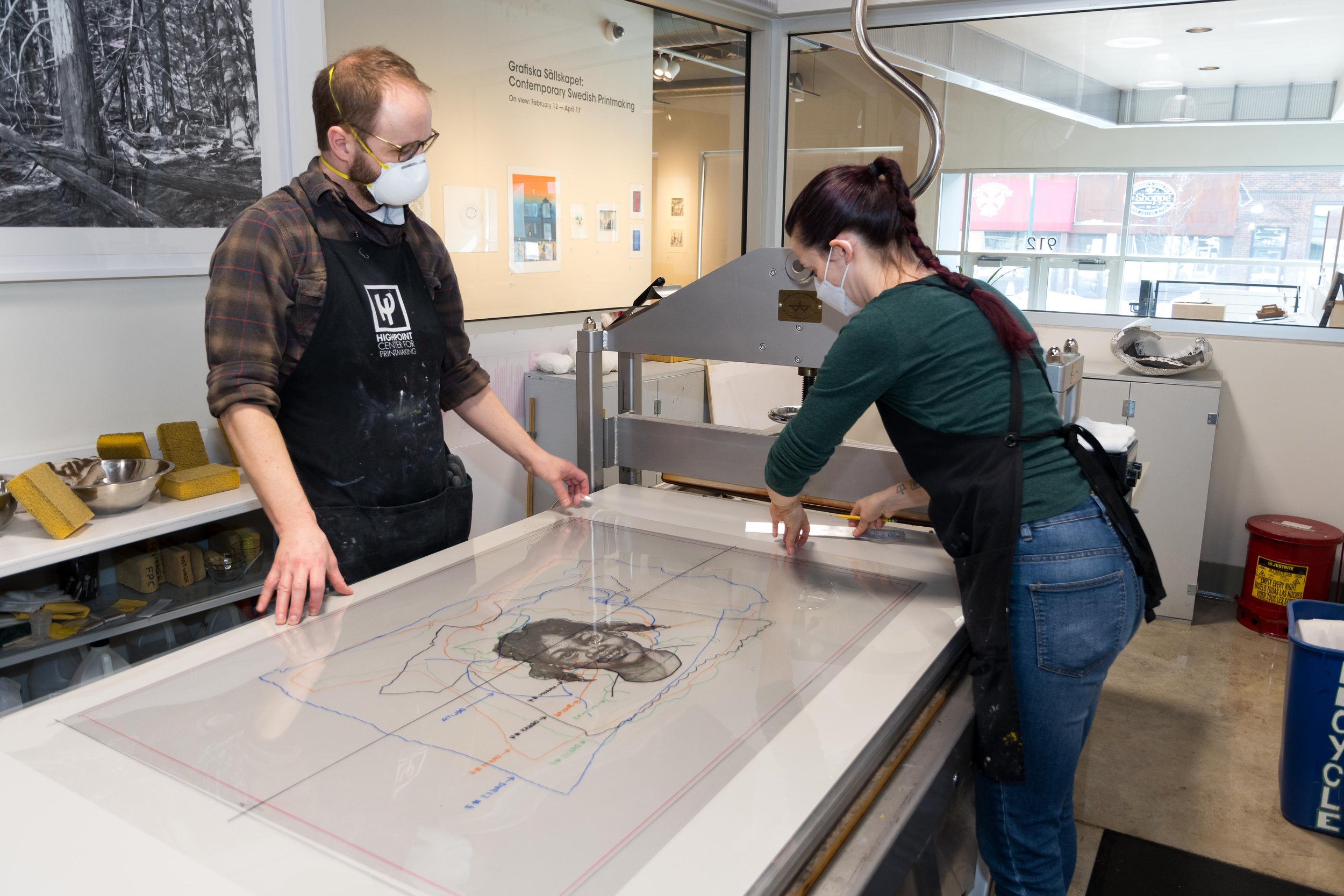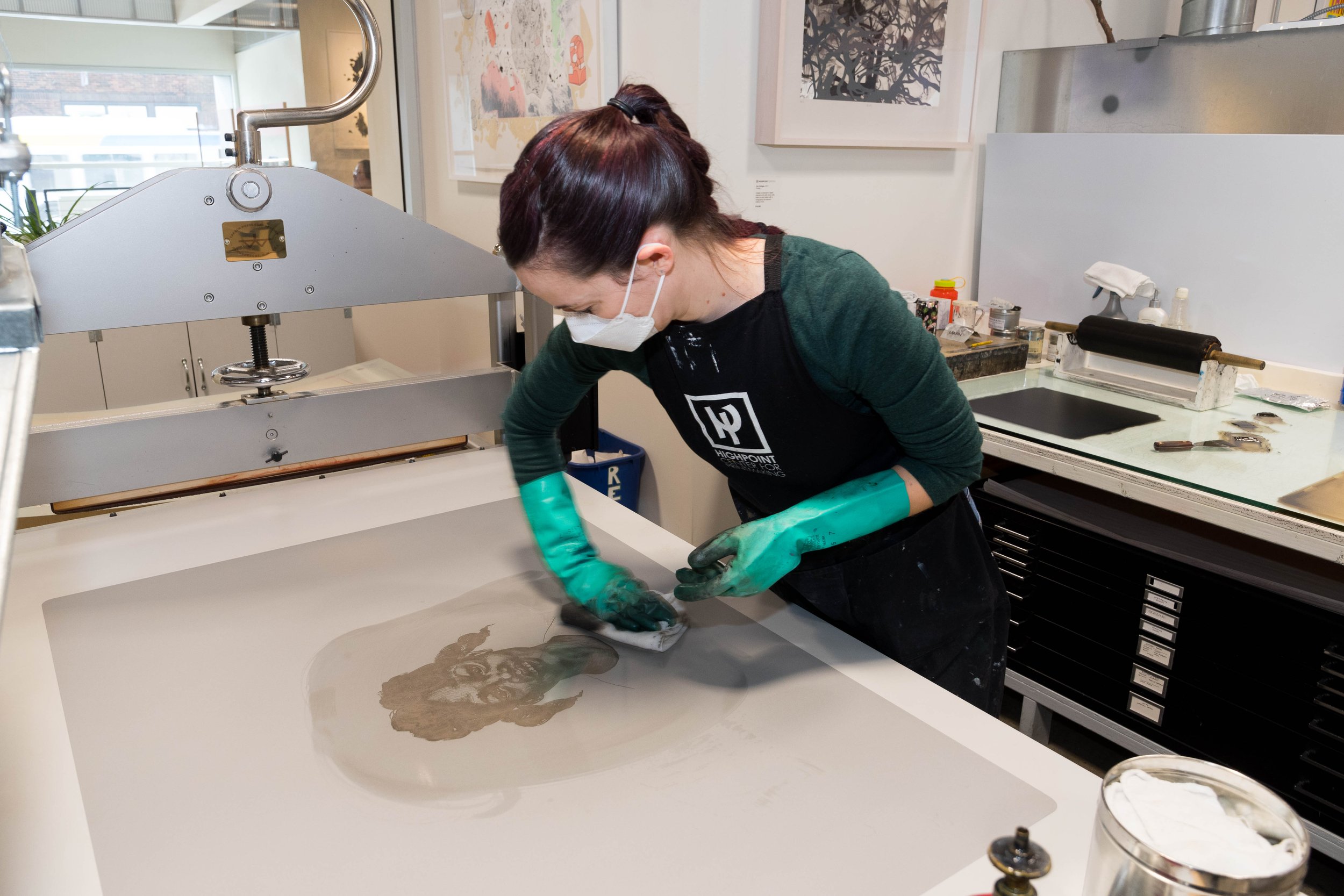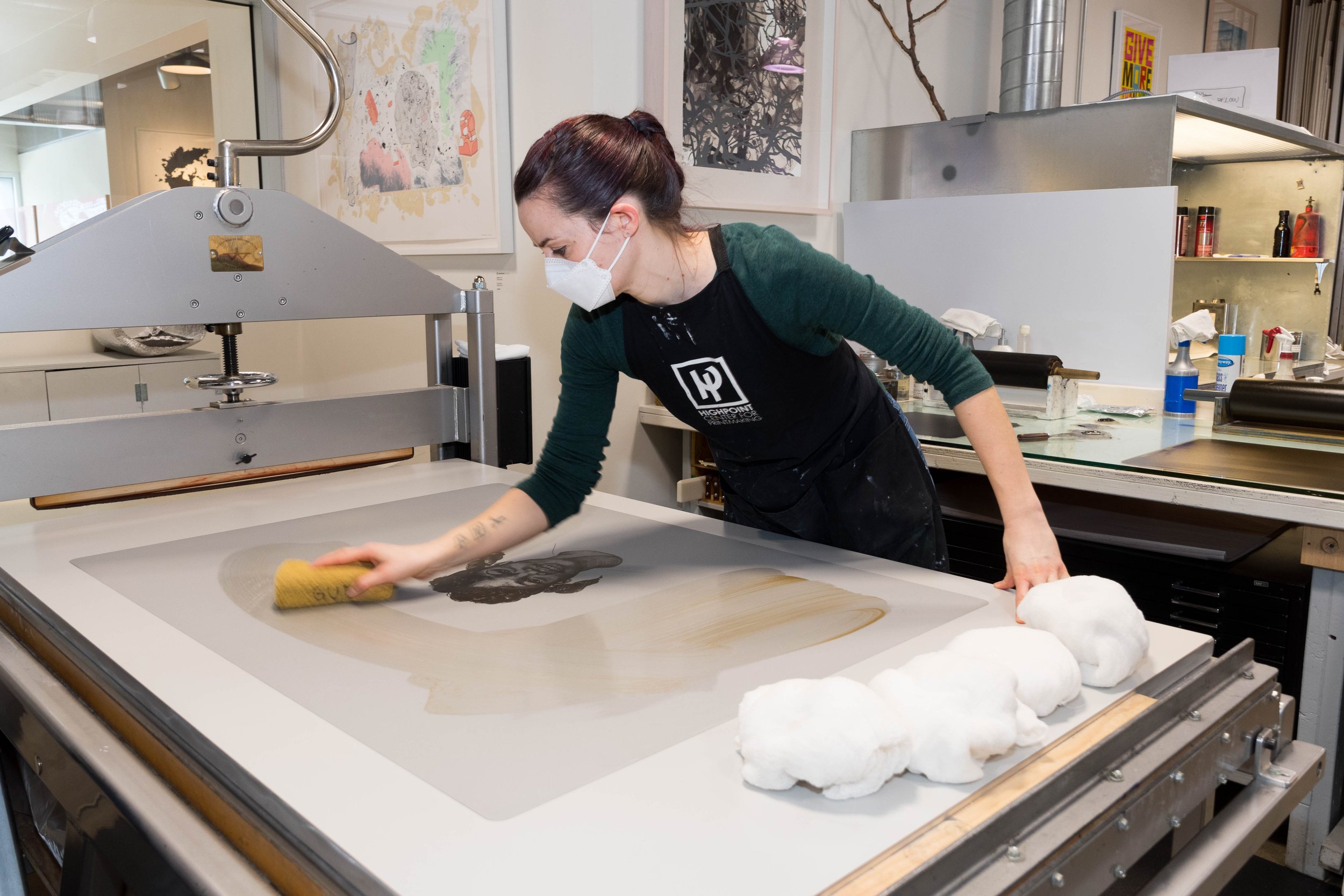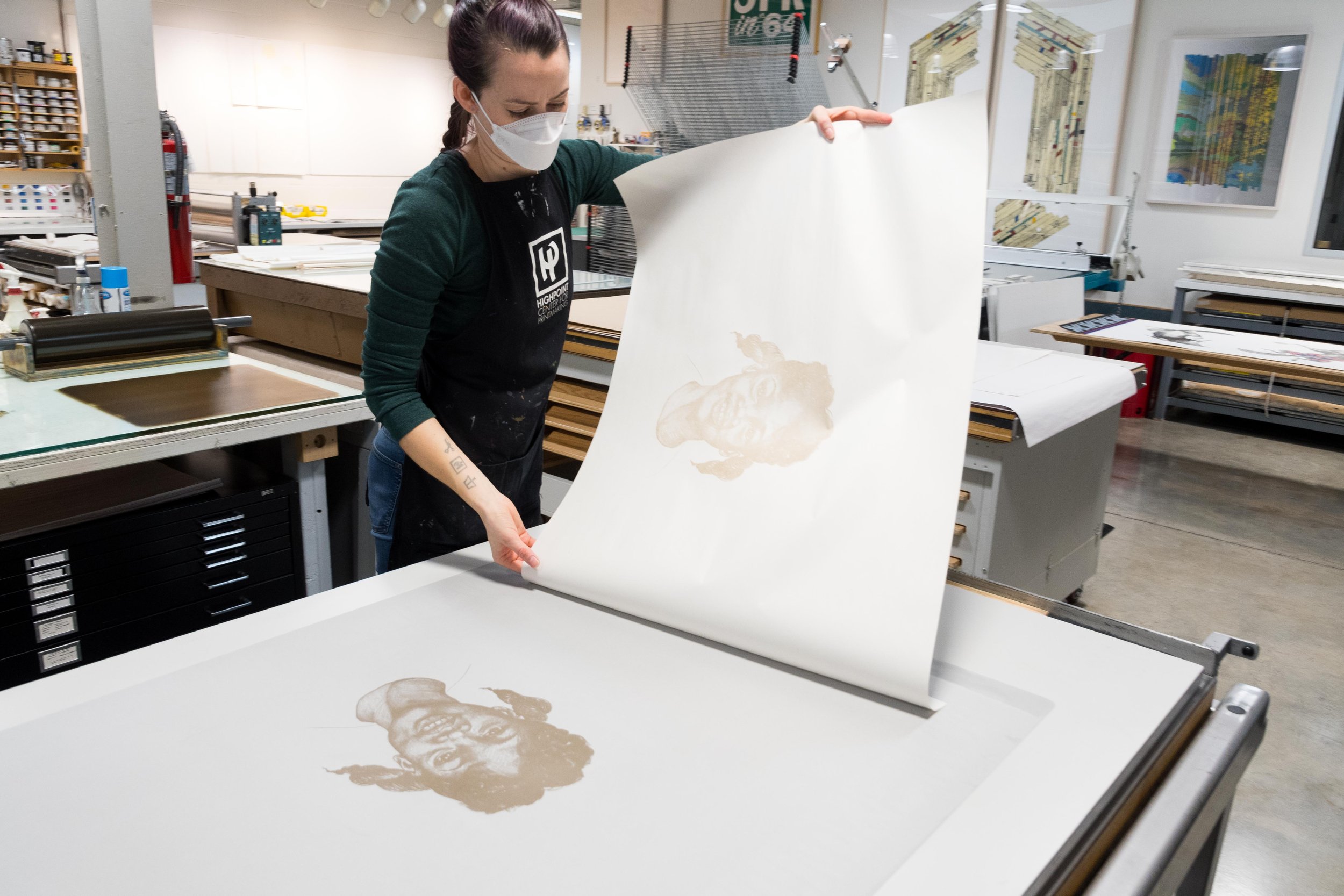Meet co-op member Megan Wetzel!
Interview with Savannah Bustillo, Jerome Resident and Co-op Artist
My name is Savannah Bustillo and I am a queer Latinx printmaker, book artist, and papermaker originally from Albuquerque, New Mexico. I received a BFA in studio art with a concentration in printmaking from Washington University in St. Louis, and have spent time working with different art non-profit spaces like Pyramid Atlantic Art Center in D.C, the Morgan Conservatory in Cleveland, Anderson Ranch Arts Center, and Women’s Studio Workshop. Currently, in addition to being a part of the Highpoint community, I also work with the Minnesota Center for Book Arts, Fireweed Community Woodshop, and the Walker Art Center.
I moved to the Twin Cities in 2019 because of the amazing printmaking and book arts scene that’s here. Highpoint is such a pillar of the printmaking scene, both in the Twin Cities and beyond, so finding a way to be a part of the community was something I wanted from the beginning.
Highpoint, like so many print shops I have been fortunate to be a part of, does such incredible things but is a relatively small operation. It’s approachable as a community space in that regard - I love walking into the studio and knowing the staff and other community members. While I was featured in a show at Highpoint in 2020, I really got to know the community through a 2021 Jerome Early Career Printmakers Residency, and have continued on as a co-op member since then.
I feel very strongly about the fellowships, scholarships, and residencies that Highpoint uses to support emerging artists and people that have been historically underrepresented in the print shop. So often printmakers will talk about the democratic origins and abilities printmaking has to reach large groups of people. However, printmaking cannot endure as a discipline and claim to still be connected to those values if we don’t remember in equal measure that it takes effort to support new generations of emerging printmakers and those that are too often excluded from the printshop. As a community member I am proud to see Highpoint support emerging artists with the Jerome Residency, and the new Full-Color print fellowship and scholarships. These are key first steps in working towards creating an even stronger and more vibrant community.
It is difficult to convey how formative the Jerome Residency was for me. As an emerging artist, studio space, especially as a printmaker, is hard to come by and a difficult stretch financially. Not only was having that space for 9 months so key to continue making, but gaining a whole community of support - my fellow residents, Highpoint staff, meeting other artists in the studio regularly, having designated critiques — all of these aspects were fundamental to pushing my studio practice forward.
I began my residency focusing heavily on research and writing, and I was a little slow to get into the studio for the actual printing if I’m honest. Josh was particularly encouraging in that respect — and reminded me that output is not the point. The critiques were also key; our conversations, like all good conversations, stayed with me and helped me focus the body of work I wanted to create for our show. That mindset - of using this residency as an opportunity to create a completely new body of work, with each piece being slowly developed in tandem with the other works - was a new way of working for me. I had never had the time or resources to make work at that pace and so holistically before. I wanted the work I created for the show to all focus on the different visceral aspects of language - how language is spoken, pronounced, attached to smells, flavors, reading, scribbling. My work has been exploring histories of language for a while, but using more emotive and visceral responses in the work was a key change to make it more approachable for viewers. I feel that everything I produced was really an extension of the efforts, conversations, and support of the community around me, and that is special. I’ll never forget that.
You can find more of Savannah’s work here.
Interview with Board Chair, Jerry Vallery
I’m originally from the Washington D.C. Growing up, my family spent a lot of time experiencing the great museums, theaters, and galleries that DC has to offer. My parents also believed in giving time and talent to those causes and organizations that were important to you. Through that, not only did I develop a love and appreciation for the arts in many forms, but I also saw firsthand what it meant to give back to your community.
I earned my undergraduate and graduate degrees from Florida A&M University and moved to the Twin Cities in 1996. Much of my professional life has been spent in corporate sales, and consumer insights and analytics roles. I like to say that my job is about blending science and art, by leveraging data to craft compelling stories.
I live in Minneapolis with my wife, Teresa, and our son Landon. We enjoy the local arts community, spending time outdoors, and traveling.
WHAT DREW YOU TO HP?
I was really drawn to Highpoint’s mission. It often goes unmentioned how ambitious the commitment is to provide a state-of-the-art workshop for practicing artists; to establish an Editions program that creates work through collaboration with nationally and internationally recognized artists; to maintain a beautiful gallery space and execute several exhibitions each year; and, then to enhance local arts education by providing education programming for hundreds of school-aged kids each year.
How could you not want to be part of an organization like that??
Jerry viewing artwork at the QUE CONSTE /FOR THE RECORD opening reception
WHAT HAS BEEN YOUR INVOLVEMENT?
Since joining the board, I have served as Secretary, Board Co-Chair, and now as Board Chair. My experience has been truly wonderful. I’ve had the opportunity to learn from so many experienced board members, artists, and especially from our founders Carla and Cole. The knowledge, expertise, and passion at all levels is a constant inspiration to me.
WHAT PROGRAMS DO YOU FEEL MOST PASSIONATE ABOUT?
If I’m forced to choose one(!), then it would have to be education programming. Central to HP’s mission is promoting the art of printmaking. And, I believe an important step in achieving this is to provide an introductory experience that is both welcoming and that gives that student a sense of possibility…that feeling that “I can do this”. I think Highpoint does an awesome job at providing that experience.
WHAT DOES IT MEAN TO BE PART OF THE HP COMMUNITY?
I think being an active part of the HP community means you believe in the connection and relationship between art and community more broadly. You believe that arts organizations shouldn’t exist in a vacuum, where they create and exhibit work that fails to acknowledge the world beyond its walls. It is not a static state that we reach and stop, of course, but an ongoing shift in how we engage. So, for me, being part of the HP community means that you care about that engagement.
I am really excited about the future of HP. We will continue to keep the endeavor of promoting printmaking as our north star. But there should be excitement and curiosity around exploring new ways to continue this journey. Whether it is leveraging technology to expand access to our collections or creating work and curating exhibits that expand our audience. While we build upon a strong foundation, we should challenge ourselves to reach out into new directions.
Interview with artist and instructor, Lila Shull
My name is Lila Shull, and I am a new(ish) Minnesotan. I moved here late last summer from Tennessee primarily because I knew of Highpoint’s reputation as a community space and Minnesota’s support for artists in general. I have a BFA in painting from Winthrop University, a small liberal arts school in Rock Hill, SC. I received my MFA in Printmaking from the University of Tennessee-Knoxville in 2019. My experience in the arts is wide-ranging; in the time between schooling, I was a lead press operator for a fine art screenprinting studio, and I also managed a design letterpress studio for a time. Currently, I’m teaching at the University of Minnesota and am lucky to also be the Community Programs Coordinator at Minnesota Center for Books Arts.
This is the first time I have seen a community print shop that has the capacity to offer all the primary printmaking techniques (lithography, etching, relief, and screenprint). From the minute I reached out about joining, I have felt like a member of the community. Initially, I was drawn to the equipment access because it is so rare to be able to work on these niche processes outside of academia. After joining, I’ve been blown away by HP’s rare opportunities, like taking classes, proposing classes, biannual member exhibitions, artist consignments, working memberships on a sliding scale, and sharing space with other practicing artists in a non-competitive environment.
Right after I joined, there was a call for workshop proposals, and I used it as an opportunity to shake off some studio practice cobwebs. I taught a six-week sharpie lithography class in the spring, which was terrific. I also taught a sampler session this past summer and have a couple more scheduled for this winter. I’m as involved as they will allow me to be. I can't overstate how amazing my experience has been so far. HP has served as a social lifeline since moving to a new city. I’ve been able to form rich friendships with the people I have met through the co-op, and it’s a privilege to make work alongside some of the most talented artists I have ever seen.
For me, I think the education programming and co-op membership are both really special. Having had the privilege of proposing workshops and leading some, this has been an amazing way to feel re-energized in the studio. I am excited to take a class at HP in the future and always have my eye on the schedule. Additionally, the co-op membership is great because there is a tiered payment system that includes pricing differences depending on your involvement. This has been helpful for me to continue to access the space, and it tears down some of the financial barriers that monthly memberships accrue. I hope HP continues to expand on these options in the future because it brings in so many different people who make the space more welcoming and diverse.
On Julie Mehretu's Corner of Lake and Minnehaha, by Susan Tallman
The tricky bit of sublimity, Edmund Burke acknowledged in 1757, is the balance between profusion and disorder: we feel awe at the night sky because “the stars lie in such apparent confusion as makes it impossible on ordinary occasions to reckon them. This gives them the advantage of a sort of infinity.” But to artists who would seek to imitate this effect, Burke issued a caution: “unless you can produce an appearance of infinity by your disorder, you will have disorder only.” The works of art that succeed at this game “owe their sublimity to a richness and profusion of images, in which the mind is so dazzled as to make it impossible to attend to the exact coherence and agreement of the allusions.”
The sublime, in Burke’s sense of aesthetic experience entangled with peril, has often been invoked in relation to the careening, elegant mayhem of Julie Mehretu’s art. The superfluity of images that tumble across her prints and paintings succeed in defying “exact coherence,” even while suggesting elusive relationships of vast design. But where earlier painters found the requisite menace and majesty in storms at sea and vertiginous mountainscapes (J.M.W. Turner is the poster boy here), Mehretu’s topography is geopolitical. She has described herself as a “child of a failed revolution” (her Ethiopian-American family relocated to Michigan as the post-Selassie nation devolved into a bloody quagmire), and the opposing forces that drive her abstractions—energy and entropy, construction and destruction—have been soldiers in every campaign ever waged for utopia.
Mehretu’s infinity unfolds in layers, each rooted in a different way of thinking about the world and a different way of drawing it. Her marks may be fuzzy or lapidary, may swoop like a raptor or stammer like scuffs on a drum head, their relationships chafe as well as bind. As a graduate student she thought of her gathered lines as “social agents.” Even in painting her working habits—drawing, separation, layering, relocation—are endemic to printmaking, and it is not surprising that she has proved to be a prolific and virtuosic printmaker, collaborating with eminent print workshops on both sides of the Atlantic, almost always in etching. 1 Her projects with Highpoint are the exception. 2
In her new prints and two earlier ones from 2003-4, Mehretu stepped away from etching’s airs and graces in favor of screenprint and lithography, once-commercial methods whose virtues include deadpan flatness and an aura of real-world plausibility. Her very first print with Highpoint, Entropia (review), features twenty-eight colors of screenprinted ink splashing east and west like the parting of a psychedelic Red Sea. Line drawings in long arcs, staccato bursts and curling filaments float in and around the spray, along with modernist architectural renderings agleam with the blithe promise of a better future. The print, like all her work, is the product of staged accretion. It began with a sixteen-layer drawing in Photoshop from which sixteen printing screens were made. She then made four further drawings on translucent mylar for lithographic plates to capture greater tonal nuance and detail. To reach the final composition, further colors were added during proofing, including translucent white layers to provide an atmospheric perspective akin to the clear acrylic layers in her related paintings).
In the meantime, however, Highpoint master printer Cole Rogers had been smitten with the appearance of Mehretu’s translucent black-and-white drawings stacked on their own. He suggested printing each of the litho plates on a separate sheet of Gampi (a thin Japanese paper), and mounting them one over the other. Pleased with the result, Mehretu tweaked the composition by adding a fourth lithographic plate. In both prints, the viewer is suspended in ambiguous space, but in Entropia (Construction), this disorientation is augmented by an eerie sense of sagittal depth, of things at a distance seen through not-quite-transparent air.
Seventeen years later, the arrival of Mehretu’s mid-career retrospective at the Walker Art Center provided an opportunity to revisit screenprint and lithography with Highpoint. She had since moved away from the kind of architectonic line drawing that underpinned the Entropia prints; photographs shot at points of jeopardy: border crossings, political protests, wildfires. Reduced to pulsing clouds of color, the action is impossible to identify in terms of location or protagonists, but even (or perhaps especially) in this state, Mehretu saw curious echoes of European grand manner history painting—a kind of formal structure and moral swagger that can be traced from Gericault’s The Raft of the Medusa (1818-19) to Joe Rosenthal’s Raising the Flag on Iwo Jima (1945) and beyond. Her hand-drawn overlays had also changed, growing looser and more expressive, and now swept like dark squalls across the new bokeh backdrops.
The new project began with a photograph of a striding protester carrying an inverted American flag and backlit by a liquor store in flames, a scene captured by AP photographer Julio Cortez four days after the murder of George Floyd and two miles due east of Highpoint, on the corner of Lake Street and Minnehaha in Minneapolis. The event was real, but were it a painting, it would have owed much to Eugène Delacroix’s exemplar of heroic hokum, Liberty Leading the People (1830), with its barefoot and bare-breasted (why?), heroine marching over a pile of corpses, the tricolor held aloft in her right hand, a bayonet in her left, while saber-rattling Frenchmen take up the rear amid martial smoke.3 The Minneapolis protester carries a bottle rather than a bayonet, but the flag, the fire, and the phoenix-like equation of destruction with rebirth attest to a continuum of political hope and rage.
Mehretu cropped the photograph, then flipped it upside down and blurred it. Though in etching she had used photo-blurs of almost diaphanous refinement, in screenprint she aimed for a coarser print terrain. In most industrial printing, all the colors of the rainbow are approximated through dots in four colors: cyan, magenta, yellow and black (or “key,” giving the process its acronym “CMYK”). The dots wax and wane in size in accordance with the colors they aim to replicate, but are regularly spaced in four interlocking grids. If the grids are fine enough, the trick works seamlessly: a speck of blue sits next to a speck of magenta, and the viewer thinks “violet.” When the resolution is less refined, weirder things happen.
Oversized “Ben Day” dots were a trope of Pop art, a tool that turned the workings of mass media into subject matter, but while Mehretu’s enlarged dot screen can be seen as a nod to photojournalism, she was less interested in the dots per se than in the visual pitter-patter of those grids as a battleground for drawing. The soft blurs now calcified into jittery rosettes of spots. Omitting the “key” black component produced a porous structure with a kind of visual tooth, while the edgy snap of screenprint means that each component reads as a discreet entity (every dot is an island, entire of itself). Over this she drew three layers of addenda, each for a different screen, each screen printed in a different black (yellow-black, purple-black, and flat black). Finally, small bursts of color were peppered on top, like flickering halations.
The dot-screen colors of Corner of Lake and Minnehaha (co-published with the Walker Art Center) reflects the incendiary palette of the original photograph (and of Minneapolis in June 2020). Her drawing layers, smoky and diffuse, operate less as strata than as currents, flowing through one another and backwards and forward in space. Each was executed with different drawing technique: one with wispy airbrush strokes; another with swift feathered marks in the manner of sumi-e brushwork; the last as a computer “dither” drawing, with spray-paint-like splotches and the kind of clean-edged wormholes familiar to anyone who has ever played with the eraser tool in Photoshop.
In the digital world, “dither” denotes the application of stochastic interference to disrupt unwanted patterns that arise when continuous information is quantized. The crude color chunks that show up in low-contrast digital images, for example, can be broken up with a spray of random dots; in sound recording, inaudible amounts of white noise can obliterate the phantom tones produced when slightly different data points are rounded to the same value. Dither, somewhat poetically, is noise as a means to quiet. Mehretu’s dither drawing is not there to fix an error but—like the jangly checkerboard of CMY dots and the quixotic fall of ink from bristles—to defy and subvert the temptations of a single coherent storyline.
In the wider world, “dither” means something else—an indulgent indecision or cozy species of panic. In both senses, it is a cousin to Burke’s dazzle: an agent of confusion endowed with strange aesthetic powers and possible wisdom. The perception of phantom patterns within complex events, after all, is the defining feature of conspiracy theories. And a mind “so dazzled as to make it impossible to attend to the exact coherence and agreement of the allusions” is a mind able to accept complexity without resorting to fables.
Burke wrote his treatise on the sublime as a young man, but for most of his life he was a politician, and his long career in Parliament encompassed both the American Revolution (he was sympathetic to the colonists) and the French (he admired the spirit and was appalled by the execution). Mehretu, the child of a more recent, failed revolution, has made herself a poet of the social sublime—the dithering, dazzling spectacle of humanity’s infinitely hopeful, endlessly myopic designs for the world. “The compositional and structural issues in my work are directly tied to the desire to take up arms and lead revolution,” she told Phong Bui around the time she began working on these prints. “But my effort is to question these gestures, to take these myths apart.”4
— Susan Tallman
Susan Tallman is a writer, critic and art historian living in Massachusetts and Berlin. She has written extensively on contemporary art, the history of prints, and other aspects of art and culture. A regular contributor to New York Review of Books among other publications, she has authored and co-authored many books, most recently No Plan At All: How the Danish Printshop of Niels Borch Jensen Redefined Artists Prints for the Contemporary World. In 2011 she co-founded the journal Art in Print, and served as its Editor-in-Chief until its closure in 2019.
Educated at Wesleyan and Columbia Universities, she is Adjunct Associate Professor of Art History, Theory and Criticism at the School of the Art Institute of Chicago, and sits on the Editorial Board of Print Quarterly. (And, yes, she was a founding member of the New York guitar band Band of Susans.)
For inquiries about Julie Mehretu’s prints, please contact the Gallery Director: sara@highpointprintmaking.org.
Highpoint welcomes new Executive Director
Highpoint Center for Printmaking Hires New Executive Director
Jehra Patrick to continue tradition of artist support, community education through printmaking
Highpoint Center for Printmaking announced Jehra Patrick as their new Executive Director, officially starting Aug 1, 2022. Patrick comes to Highpoint from her positions as the Gallery Director and Curator at Macalester College and as Founder and Director at Emerging Curators Institute.
“Highpoint has come to a very important moment in its history. As we began the search for our next Executive Director, one of our top priorities was to find the person who would be most successful at honoring Highpoint’s mission of promoting the art of printmaking,” said Jerry Vallery, Board Chair of Highpoint. “That remains core to who we are as a unique arts organization. Jehra is most capable to lead Highpoint by enabling its core mission and effectively navigating the context of a changing environment.”
Patrick has shaped her career through the arts organizations she has served. Her leadership includes experience in strategic transitions, fundraising, developing teams, educational programming for all ages and building advocacy for arts through boards and committees. Her roles with Macalester College and Emerging Curators Institute allowed her to incorporate support and enhanced multicultural perspectives both in galleries and a curator fellowship. Previously, Patrick provided strategic direction for Mn Artists, a long-standing state-wide program of the Walker Art Center. Patrick also founded and directed Waiting Room, an exhibition and public programming space.
“I am invested in the arts and the people who power them—artists, arts workers, and the audiences and communities they serve—and I am excited to build on Highpoint’s mission and outstanding legacy.” said Patrick. “Together, we will collectively share the story of Printmaking, its global history, production processes, and artistic labor.”
Highpoint Center for Printmaking is known as the only printmaking center of its caliber in Minnesota. Established over 20 years ago, Highpoint nurtures the art of printmaking through artist support and accessible community education. In succeeding the founder and interim director, Patrick will continue that vision for Highpoint to further the art of printmaking in exceptional ways.
About Highpoint Center for Printmaking:
Highpoint is a nonprofit organization dedicated to advancing the art of printmaking. Its goals are to provide educational programs, community access, and collaborative publishing opportunities to engage the community and increase the appreciation and understanding of the printmaking arts. Highpoint Center for Printmaking offers a variety of programming including educational classes for kids, adults, and community members, a print shop co-op space that provides access to local artists to create work in a supportive workshop environment, a visiting artist program with national and international artists who can produce work with a master printer, creative residency, fellowship, and scholarship programs to support early career and professional artists, and a gallery space that is fully accessible to the public. Highpointprintmaking.org
Press Contact: Carol Schuler, carol@cschuler.com
Welcome, Full Color Print Fellows!
Introducing Victoria Eidelsztein and Jasper Duberry
as Printmaking Fellows and HP Co-op Members
We are sending a warm welcome and congratulations to Jasper Duberry and Victoria Eidelsztein as the new Full Color Print Fellows at Highpoint Center for Printmaking. With the guidance of a steering committee, this program has been in development since 2019 for the purpose of creating a more diverse and equitable space for artists of color to participate, create work, and engage in the printmaking community! We are thankful to the steering committee and all of the individual donors and family foundations that helped make this program possible now and into the future!
Jasper Duberry is a printmaker that resides in St. Michael, Minnesota. Jasper learned printmaking at Viterbo University in La Crosse, Wisconsin. Jasper often explores themes that are various stages of the Black experience – pain, joy, healing, and resistance to name a few.
As Michelle Alexander, author of The new Jim Crow: Mass Incarceration in the Age of Colorblindness writes, “Slavery defined what it meant to be black (a slave), and Jim Crow defined what it meant to be black (a second-class citizen). Today mass incarceration defines the meaning of blackness in America: black people, especially black men, are criminals. That is what it means to be black.”
Victoria Eidelsztein is an Argentinian artist and screenprinter based in Minneapolis. Victoria’s artwork reflects on simple yet complex themes like loneliness, self-care, and homesickness. “My immigration process started in 2019 and coincided with the pandemic which delayed my documentation. This created a very delicate situation for me; I found myself very lonely, not being able to work or go back home, and I was feeling very homesick without a sense of belonging. My artwork was shaped by these events and overwhelming feelings, and printmaking became a powerful tool to express them.” In one image, Victoria’s blue women are alone in the middle of the paper, without any background or elements that ground them; they seem to be floating but they always have themselves. Victoria prints her drawings on paper and apparel and is currently exploring large-scale fabric printing techniques, creating tapestries with intricate patterns.
Victoria offered this about her practice and how the fellowship will be a benefit: “My practice now is mainly focused on screenprinting; I also do ceramics and paint murals. Recently, I learned how to sew which expands the limits of my creativity and gives me access to new formats. Being selected for the Full Color Print Fellowship is a dream! Having access to a fully equipped studio, mentorship, and guidance for a year will help me expand artistically but also be able to create on a higher level and even larger scale.”
Full Color Print Panelists
Highpoint would like to sincerely thank the panelists Witt Siasoco and Anika Schneider for their careful review and discussion of the submitted applications and for their generous offer to provide feedback directly to the applicants. More about panelists can be found below.
Witt Siasoco (he/him) is a community-based, visual artist living and working in Minneapolis, MN. His work actively engages the intersection of the arts and civic process through a variety of roles—as an artist, graphic designer, and arts educator.
In recent years, Siasoco was awarded a Minnesota State Arts Board Arts Access grant, Metropolitan Regional Arts Council’s Next Step Fund, and Jerome Hill Foundation Fellowship. He has had residencies at the Kulture Club Collaborative, Pillsbury House and Theater, and Minnesota Museum of American Art. Siasoco was selected as a CreativeCitymaking artist, a collaboration between artists and urban planners to develop innovative approaches for addressing the long-term transportation, land use, economic, environmental, and social issues facing Minneapolis. Witt's studio practice is rooted in creating art in public space that catalyzes civic dialogue and collective action.
"Throughout my experiences as an artist in the Twin Cities, I have noticed a need for more resources and access to equipment, so I am thrilled that Highpoint is launching a program that focuses on BIPOC printmakers. I hope that their initial offering grows exponentially."
Anika Hsiung Schneider is a narrative artist who draws on lived experiences, memory, and family history. With an Asian mixed female identity, she resides in a highly racialized body that also exists in a liminal state. This connection to a liminal state closely connects her work to themes of loss, transitional spaces, and visualizing the intangible.
Anika received her MFA from the Minneapolis College of Art and Design (MCAD). She currently serves as the Director of Exhibitions and Artist Programs at the Minnesota Center for Book Arts and adjunct faculty at MCAD. Anika’s work has been exhibited nationally at galleries such as Soo Visual Art Center, Rosalux Gallery, Gallery B St Paul, Circle Gallery, Visarts, Dumbarton Concert Gallery, and Glen Echo Park Partnership for Arts and Culture. Anika has also participated in residencies in Wolfsville, Nova Scotia, and Solomons Island, Maryland. She has also been awarded a Windgate University Fellowship, Gettysburg College Provost Grant, and in the InCahoots Residency Boost Prize full grant.
The Full Color Print Fellowship is an application-based initiative for artists with some level of prior printmaking experience. These artists receive a year’s membership to HP’s cooperative printshop, free access to classes and workshops, an unrestricted stipend, mentorship, and the opportunity to participate in semi-annual co-op exhibitions. The long-term goal of this program is to create a welcoming and safe environment, providing opportunities and access to artists who have been historically underrepresented in the co-op space and adult classes. Highpoint should reflect and be more representative of the community we inhabit and serve.
The Full Color Scholarship program provides access for BIPOC artists to Highpoint’s adult printmaking classes free of charge thereby helping to overcome a potential barrier to co-op membership; technical knowledge of printmaking.
Corner of Lake and Minnehaha, new print by Julie Mehretu
Highpoint Editions is proud to release the newest print by artist Julie Mehretu, Corner of Lake and Minnehaha, a co-publication which has been made through support of the artistic programs of Walker Art Center and Highpoint Editions.
This year marks the 18th anniversary of the release of one of Mehretu’s earliest prints [Entropia (review)], co-published by Highpoint Editions and the Walker in 2004.
Corner of Lake and Minnehaha, 2022
Julie Mehretu
17-run Screenprint on white Coventry Rag paper
47" x 37" image size
54 ¾" x 43 ½" paper size
Edition of 45
Current events and unfolding histories have long informed Mehretu’s practice. Her most recent works are propelled by her reaction to urgent crises in our present moment, and how the media’s framing of these conditions impacts society. From the incessant stream of daily imagery we consume of violence, injustice, warfare, and environmental disasters, Mehretu seeks out resonant photographs—of fires raging simultaneously in California and Myanmar in 2017, for example; or in the case of this print, an image from the civil unrest in Minneapolis on May 28, 2020 following the murder of George Floyd. These photographic sources, which Mehretu alters by digitally blurring, rotating, and cropping them, become the ground of her recent works. The artist then builds upon these in layers by marking over them with her own gestures to create visually and conceptually complex abstractions.
Working with Master Printer Cole Rogers and the team of printers at Highpoint Editions, Mehretu developed this work into a 17-run screenprint. This ambitious print combines a halftone dot pattern in Cyan, Magenta and Yellow along with drawings by the artist that are layered one by one in various tones of black and colored inks.
— Siri Engberg, Senior Curator and Director of Visual Arts
Pricing and availability can be found here, or you may contact jehra@highpointprintmaking.org or info@highpointprintmaking.org
In the Fold: A Critical Dialogue on Blackness + Printmaking, a conversation with Delita Martin, Chloe Alexander and Tanekeya Word
She Sent Him Back to His Mother, Stephanie Santana, 2020
“As artists, collectively and individually, we are continuously asking ourselves questions and creating artwork that are iterations of those inquiries. What unfolds is an expansion of the intersections of our lives on varied planes. Each artist will take you into the fold and invite a critical dialogue on their art praxis and discuss a homeplace they all share, Black Women of Print.”
Join us for what will be a thoughtful and powerful conversation with three printmakers, Delita Martin, Tanekeya Word and Chloe Alexander. Tanekeya Word is the founder of Black Women of Print, an organization which aims to promote the visibility of mid-career and established Black women printmakers, through accessible educational outreach, to create an equitable future within the discipline of printmaking.
Thursday, June 23, 6:30pm
$10; free for Highpoint Contributing Members
Register for the event here.
Please note that this event has limited capacity. Highpoint is not requiring masks in the gallery space as of this writing, but that is subject to change. Masks are encouraged for all attendees.
“I wanted to create a place where intergenerational Black women printmakers could form bonds like Margaret Taylor Goss Burroughs and Elizabeth Catlett. From Mid-Career to Established printmakers, it is my hope that we all can learn something from one another, support one another and also have a home so that the world can get to know the intersectional narratives of Black womanhood and our creative processes.”
— Tanekeya Word
Delita Martin is an artist currently based in Huffman, Texas. She received a BFA in drawing from Texas Southern University and a MFA in printmaking from Purdue University. Formally a member of the fine arts faculty at the University of Arkansas at Little Rock, Martin is currently working as a full-time artist in her studio, Black Box Press.
Primarily working from oral traditions, along with vintage and family photographs as a source of inspiration; Martin’s work explores the power of the narrative impulse.
Chloe Alexander is a printmaker and educator who works in various techniques to create one-of-a-kind prints, drawings, and varied editions. Chloe obtained both her BFA and M. Ed. from Georgia State University in Atlanta and has since exhibited work
widely, including at Kai Lin Art Gallery in Atlanta, the International Print Center New York, and the Woolwich Contemporary Print Fair in London
Tanekeya Word was born in the Mississippi Delta and those memories are rooted within her praxis.
In her work, she explores subaltern spaces: Black interiority in the United States of America and the cultural connection to identity, history, memory and re-memory.
Tanekeya earned a BA in English and Afro-American Studies, from Howard University and has a MA in Arts Management. She completed her doctoral
program in May 2019 and is currently an Urban Education PhD dissertator with a specialization in Critical Race Theory in Art Education.
Tanekeya Word is based in Milwaukee, WI and is the owner and sole operator of Womanist Press Studio
Highpoint Editions at EXPO Chicago
Highpoint Editions visits the EXPO Chicago
Early April, Highpoint Editions exhibited at EXPO Chicago, a fine art fair that featured over 140 exhibitors from around the country, with some international representation, as well. We exhibited new works by Julie Mehretu, Delita Martin, Rico Gatson, Julie Buffalohead and Jim Hodges, along with favorite prints by Willie Cole, Jim Hodges, Andrea Carlson, Do Ho Suh, and Lisa Nankivil.
Over 30,000 visitors attended the fair this year, and it was so clear that people were hungry for events like this one -- energy was high, and the overwhelming feeling throughout the fair were of excitement and reinvigoration from being able to view art in person. We hope to participate in this fair again!
Keepsakes, a new suite by Delita Martin
Joyce, 2021, Edition of 20
Lithography with collagraph and hand stitching
29" x 41 ½"
Named after a sister.
We are honored to be able to announce the completion of a suite of seven prints by artist Delita Martin. Martin's use of color, pattern and portraiture is powerful, and these incredibly (perhaps deceptively) tender pieces capture the same persistent and confrontational energy characteristic of her larger body of work.
Over the pandemic, Highpoint Editions worked with Martin to ship pieces back and forth, making progress remotely. Because of the size of this suite and the edition — making 140 prints in total — each one stitched by hand with embroidery thread, Martin recruited women from her area in Huffman, TX to assist with the stitching. She describes what became a kind of quilting bee, wherein she felt honored to be surrounded by these women’s conversation, let in on a time honored tradition and bestowed with community wisdom. Contributing sewists include: Sandra Sayles, Wilma J. Evans, Georgia Harper and Sandy Patterson.
The suite is available for purchase now. Please click HERE for pricing. Email alex@highpointprintmaking.org with questions!
Ann, 2021, Edition of 20
Lithography with collagraph and hand stitching
29" x 41 ½"
Named after a longtime friend of the artist.
From the artist:
Keepsakes is a series of prints that look beyond the surface of objects at the memories they hold. Their purpose is to preserve the childhood of young Black girls and act as mementos of innocence. In this way, Keepsakes is a direct act against “adultification”, a perspective where adults view Black girls as less than innocent and more adult-like, ripping away their innocence and replacing it with labels such as “disruptive”, “loud” or “manipulative”. These labels often result in their mistreatment.
This varied series shows portraits of little Black girls peering from the folds of vintage christening gowns. Such gowns, typically a shade of white symbolize innocence and purity in the Christian doctrine that teaches all men were created blameless and free of sin. However the dresses in these works are slightly yellowed signifying the passage of time and suggesting that perhaps such notions are not equally applied.
Personal objects have long been a reflection of memory, personal and cultural identity. The dresses in this series act as repositories for both memory and identity.
Trina, 2021, Edition of 20
Lithography with collagraph and hand stitching
29" x 41 ½"
Named after a sister.
Karen, 2021, Edition of 20
Lithography with collagraph and hand stitching
29" x 41 ½"
Named after a sister.
Delita Martin is an artist currently based in Huffman, Texas. She received a BFA in drawing from Texas Southern University and a MFA in printmaking from Purdue University. Formerly a member of the fine arts faculty at the University of Arkansas at Little Rock, Martin is currently working as a full-time artist in her studio, Black Box Press.
Primarily working from oral traditions, along with vintage and family photographs as a source of inspiration, Martin’s work explores the power of the narrative impulse.
Her finished works combine collaging, drawing, painting, printmaking and sewing techniques, placing her figures amid patterns to visually represent what it looks like when we become the spiritual other: when we pray or meditate … we enter the “veilscape.” Martin's layering of technique and material, as well as her use of pattern and color, signifies a liminal space – the space between the waking life and the spirit life. By fusing this visual language with oral storytelling in this different space she offers other identities and other narratives for women of color.


